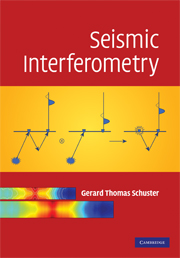Book contents
- Frontmatter
- Contents
- Preface
- 1 Introduction
- 2 Reciprocity equations of convolution and correlation types
- 3 VSP → SWP correlation transform
- 4 VSP → SSP correlation transform
- 5 VSP → SSP convolution transform
- 6 SSP → SSP correlation transform
- 7 VSP → VSP correlation transform
- 8 SSP → VSP → SWP transforms
- 9 Traveltime interferometry
- 10 Stochastic interferometry
- 11 Interferometric source estimation
- 12 Body wave earthquake interferometry
- References
- Index
9 - Traveltime interferometry
Published online by Cambridge University Press: 15 October 2009
- Frontmatter
- Contents
- Preface
- 1 Introduction
- 2 Reciprocity equations of convolution and correlation types
- 3 VSP → SWP correlation transform
- 4 VSP → SSP correlation transform
- 5 VSP → SSP convolution transform
- 6 SSP → SSP correlation transform
- 7 VSP → VSP correlation transform
- 8 SSP → VSP → SWP transforms
- 9 Traveltime interferometry
- 10 Stochastic interferometry
- 11 Interferometric source estimation
- 12 Body wave earthquake interferometry
- References
- Index
Summary
The previous chapters presented the reciprocity equations for creatingnear-target seismograms from those recorded far away. In contrast, this chapter shows how to generate near-target traveltimes from those recorded far from the target. Rather than using Green's theorem, Fermat's principle is employed to derive the VSP → SWP, SSP → VSP, and VSP → SSP traveltime transforms. These near-target traveltimes can be inverted to obtain the velocity distribution near the target. The benefit is that the distorting effects of the overburden and statics are avoided to give a better velocity resolution of the target body. Numerical examples are presented that validate these traveltime transforms.
Introduction
Reflection tomography was developed by Bishop et al. (1985) and Langan et al. (1985) to provide an accurate velocity model for seismic migration. Unfortunately, the reflection tomogram often lacks sufficient resolution to resolve detailed vertical and lateral changes in a layer's velocity. Part of the reason is that the local traveltime residual associated with wave propagation within a thin layer is tangled up with the global traveltime residual. Here, the global residual is the traveltime error along the entire length of the reflection ray. The mixing of both local and global traveltime residuals, including statics, precludes an optimal resolution of the layer's velocity.
A possible solution to this problem is to lower the sources and receivers from the surface to the interface of interest, as is done with crosswell experiments (Harris et al., 1995). In this case, the traveltime residuals are localized to the layer of interest to provide high-resolution estimates of the interwell velocity distribution. However, crosswell experiments are expensive for exploration seismologists and improbable for earthquake seismologists.
- Type
- Chapter
- Information
- Seismic Interferometry , pp. 177 - 188Publisher: Cambridge University PressPrint publication year: 2009



